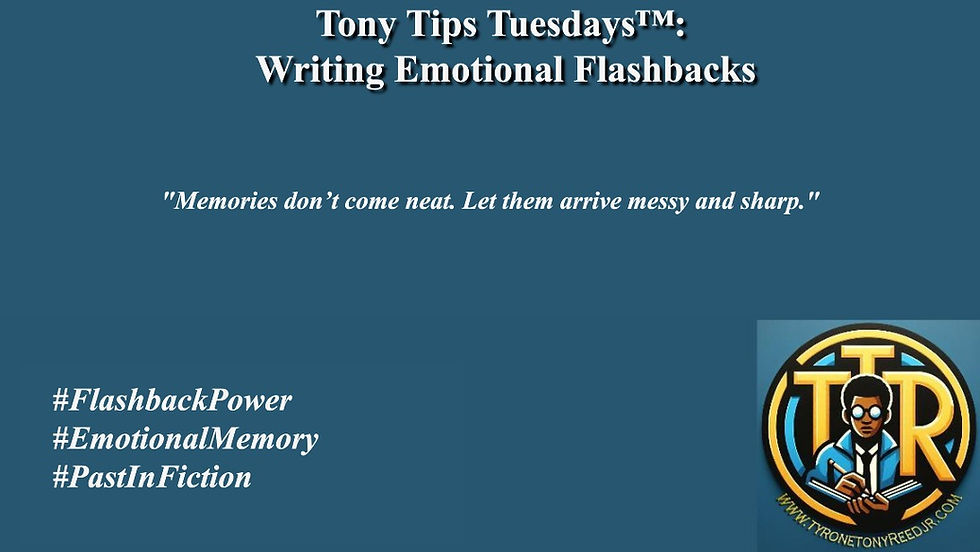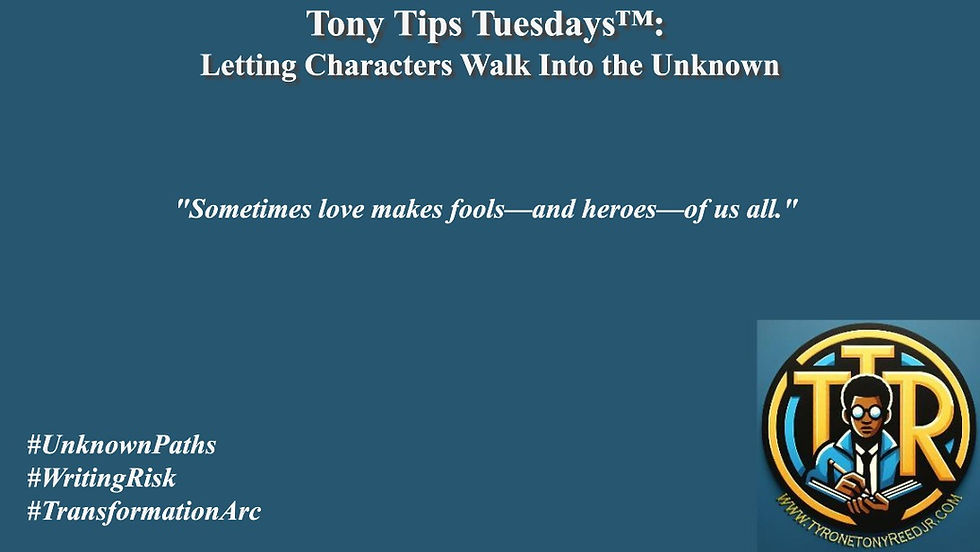Tony Tips Tuesdays™: The Power of Character Motivation
- Tyrone Tony Reed Jr.

- Sep 9
- 5 min read

At the core of every unforgettable story lies a driving force—a why that compels characters to act, take risks, make sacrifices, or crumble under pressure. That driving force is called motivation, and it’s the difference between characters that feel alive and those that fall flat. It’s not just what they do that matters—it’s why they do it.
In storytelling, character motivation is everything. It fuels the plot, creates tension, crafts memorable arcs, and binds readers emotionally to the journey. Without it, your characters become passive, your conflict becomes shallow, and your readers—no matter how beautiful your prose—lose interest.
Today’s post is a deep dive into not just understanding character motivation, but mastering it. Whether you're a novelist, screenwriter, comic creator, or storyteller of any kind—this is the heartbeat of your story.
📌 Why Motivation Is the Lifeblood of Storytelling
Imagine reading a novel where the hero saves the world—but you have no idea why. Or a villain unleashes chaos—just because. These types of characters become caricatures. Motivation gives meaning to action.
It explains why a character does what they do.
It determines how they handle success, failure, love, loss, and betrayal.
It provides the foundation for growth or downfall.
Think of motivation as the invisible engine behind every decision, conflict, and transformation.
Without motivation, you don’t have a character. You have a puppet.
📌 Understanding Internal vs. External Motivation
All strong characters are driven by a combination of:
✅ External Motivation – Tangible, visible goals. These are plot-based objectives: Win the race. Rescue the hostage. Make the team. Escape the town.
✅ Internal Motivation – Emotional, psychological needs. These are personal and rooted in backstory: Prove I’m good enough. Be seen. Find love. Overcome fear. Earn forgiveness.
🧠 Powerful storytelling happens when internal and external motivations intertwine.
Example:
External: A soldier wants to return home from war.
Internal: He wants to apologize to his estranged daughter.
Suddenly, the journey is deeper, richer, and more meaningful.
📌 The Core Motivation Questions
Ask these questions early and often:
🔹 What does my character want—right now and long-term?
🔹 Why do they want it? (Go deeper than surface answers!)
🔹 What are they willing to do to get it?
🔹 What are they afraid they’ll lose if they fail?
🔹 What stands in their way?
Answering these will give your character agency—the ability to make decisions and act on their world, not just react to it.
Tony Tip: Don’t confuse goals with motivation. Goals are what they want. Motivation is why they want it.
📌 Motivation Creates Emotional Investment
Readers connect with characters who:
✔️ Have clear desires
✔️ Face opposition
✔️ Make tough choices
✔️ Struggle, fall, and rise again
Motivation gives readers a reason to cheer, cry, scream, and hope alongside your protagonist.
When readers feel your character’s motivation—when it echoes something inside their own soul—that’s when you’ve got them.
📌 Avoid These Motivation Mistakes
🚫 Motivation That’s Vague – “He just wants to be happy.”
➡️ Too abstract. What does happiness look like to him? Be specific.
🚫 Sudden Shifts Without Reason – Characters whose motivations change on a whim confuse readers.
➡️ Let motivation evolve through plot and conflict, not random pivots.
🚫 Motivation That’s Too Convenient – Don’t just give your characters what they want. Make them earn it.
➡️ The struggle is the story.
📌 Pop Culture Masters of Motivation
Let’s look at how powerful motivation shapes unforgettable characters:
🎯 Black Panther (T’Challa) – He wants to honor his father’s legacy and redefine what leadership looks like for his people.
🎯 Erik Killmonger – He’s motivated by generational trauma, injustice, and a desire for vengeance rooted in pain.
🎯 Scarlett O’Hara (Gone with the Wind) – She’s not just a Southern belle. She’s a survivor, motivated by pride, fear of poverty, and a burning need to maintain control.
🎯 Batman – His external goal is justice. His internal motivation is grief, guilt, and the need to ensure no child feels what he did.
🎯 Harley Quinn – Her motivation evolves from love and dependency to self-liberation and identity.
These characters linger in our minds not because of their powers or setting, but because of what drives them.
📌 Thumbtack This: How to Show Motivation, Not Just Tell It
📍 Let your character make decisions that have consequences.
📍 Have their motivation conflict with someone they love.
📍 Show internal monologue wrestling with “should I or shouldn’t I?”
📍 Use symbolism—a broken locket, a family heirloom—to represent their inner drive.
📍 Show how failure fuels deeper motivation (not just despair).
📌 Your Protagonist Isn’t the Only One Who Needs Motivation
Every major character—ally, rival, love interest, antagonist—should have a clear motivation.
A well-motivated supporting character can:
Challenge your protagonist’s worldview
Provide emotional stakes
Create subplots that feel alive
💥 Even your villain deserves depth.
Think: What does the antagonist think they’re doing right? Villains who believe they’re justified are terrifyingly human.
📌 Character Motivation in the S.O.L.A.D.™ Universe
Readers of S.O.L.A.D.™ know that Kevin (Angelo) isn’t just fighting darkness for the sake of being a hero. He’s driven by faith, responsibility, legacy, and love. Each battle he faces is rooted in his desire to protect—and sometimes, his fear of failing.
That’s what makes him more than just a superhero. He’s human.
📌 Advanced Tips for Writing Motivation Like a Pro
🔸 Use mirrored motivation – Characters with the same goal but different methods.
🔸 Build motivation-based twists – Reveal that the character’s true motivation was something else all along.
🔸 Let motivation conflict with morality – What if what they want will hurt someone else?
🔸 Test motivation with temptation scenes – Will they stay the course when offered something easier?
🔸 Track motivation scene by scene – Ask, “What does this character want in this moment?”
🎯 Tony Tip: Motivation Is the Soul of Momentum: If you’ve ever felt like your plot was stalling or your scenes lacked punch, it’s often a motivation issue. Revisit what your characters want. Reignite their why. Once that flame burns, everything else catches fire.
📚 Bonus Writing Prompts to Deepen Character Motivation
Your character is offered their greatest desire—but only if they betray someone they love. What do they do?
What’s a secret your character has never told anyone, and how does it affect what they want?
What’s the one thing your character would never do? Now put them in a position where doing it might save someone.
These prompts are not just for character building—they’re fuel for story explosions.
📢 Final Thoughts
The stories that stay with us—the ones we quote, reread, or cry over—aren’t just built on action or spectacle. They’re built on motivation. Readers don’t follow your characters for what they do. They follow them for why they do it.
🔑 Want unforgettable fiction? Start with unforgettable motivation.
Ask yourself with every scene, every chapter: “What does my character want… and what are they willing to do to get it?”
That’s where the magic lives.
🛍️ Want More? Explore powerful characters, emotional arcs, and divine purpose in my S.O.L.A.D.™ novel series. Order autographed copies directly from me at:
Let’s keep writing stories that don’t just entertain—they ignite purpose.



Comments